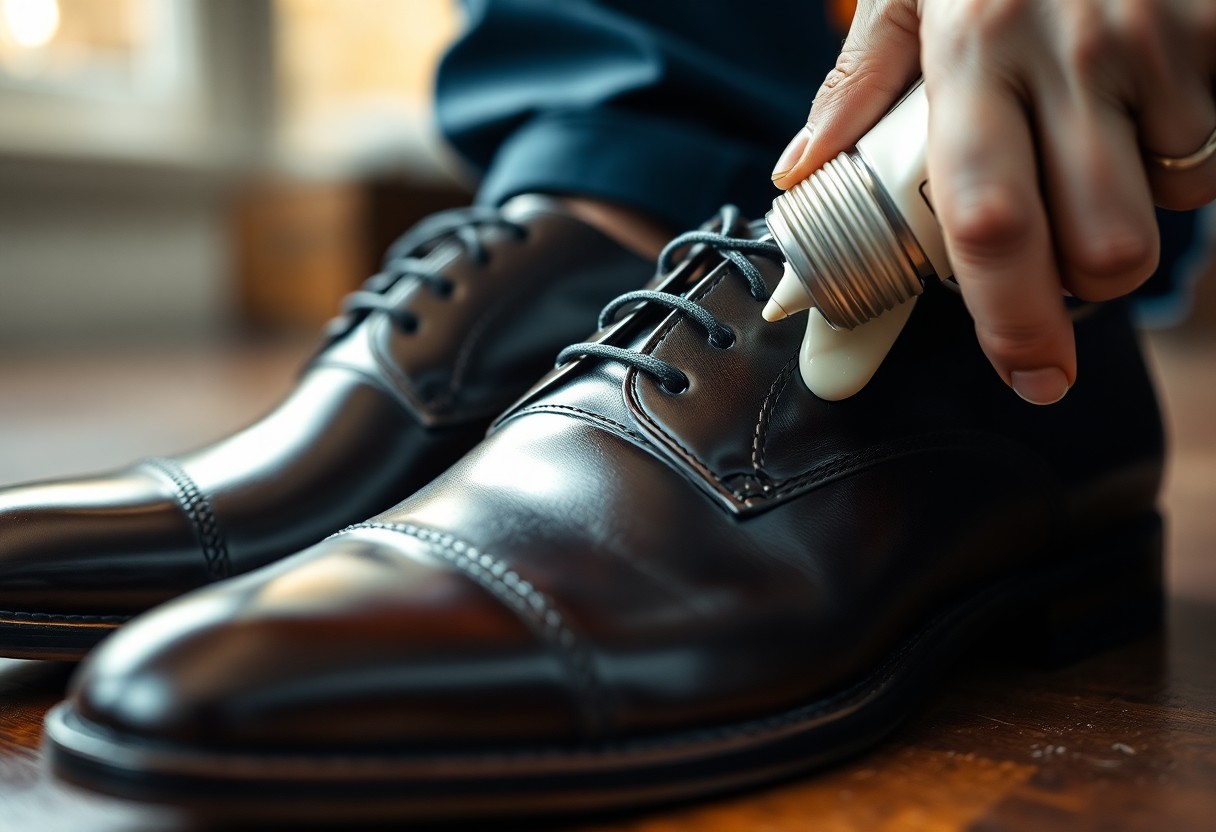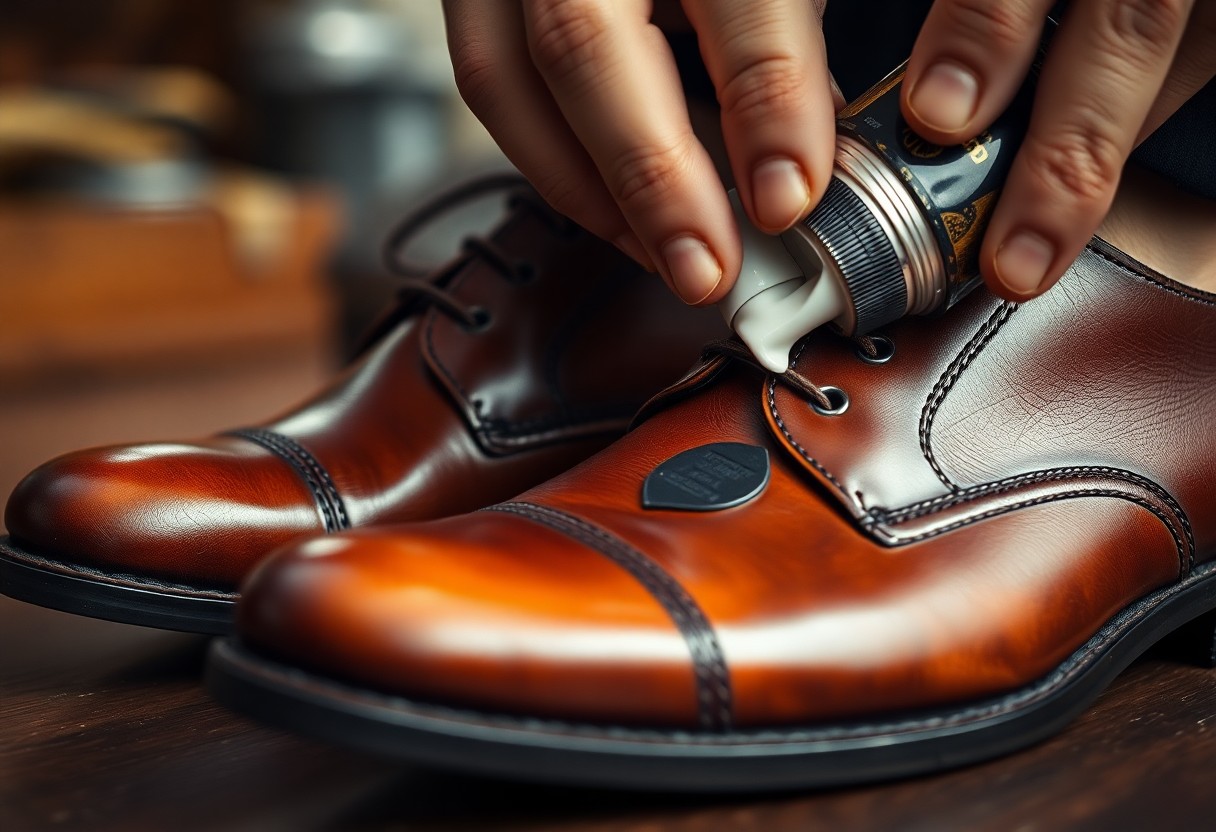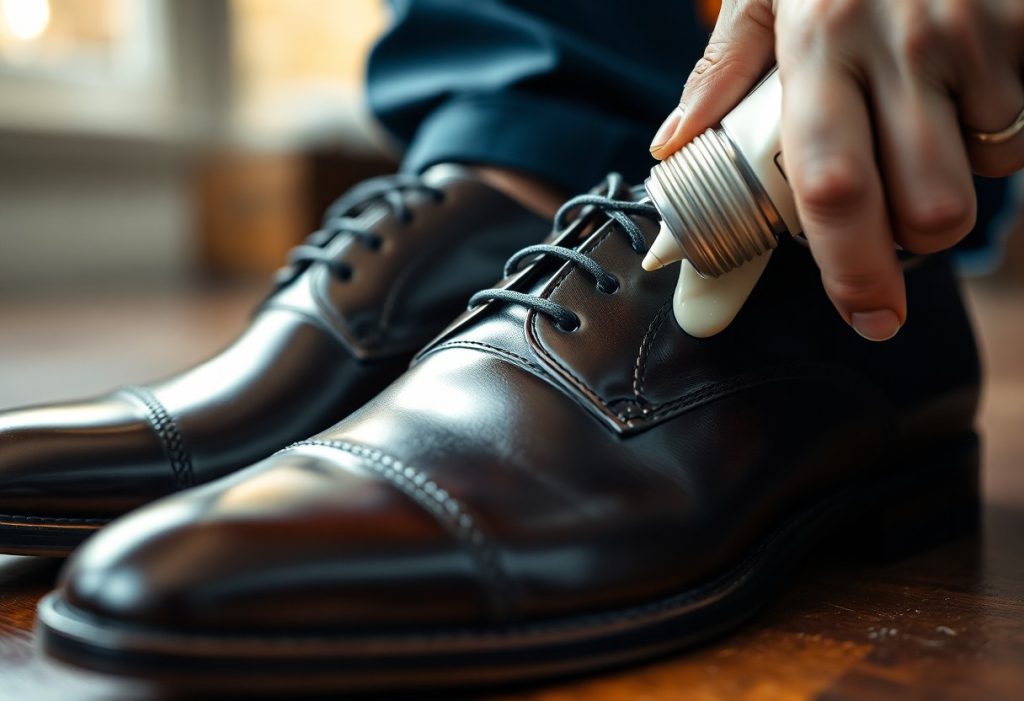Revamping your leather shoes with darker shoe cream can significantly enhance their aesthetic appeal, taking them to a more refined and sophisticated level. By applying multiple thin layers of cream in progressively darker shades, you can achieve results that look professionally executed. It’s crucial to start with a cream color that closely matches your shoe’s original hue to avoid any uneven coloring. For optimal results, utilize high-quality pigmented creams from trusted brands like Saphir Medaille d’Or or Boot Black. This method is particularly effective for lighter-colored shoes, where you will notice the most dramatic transformation while ensuring a natural finish.
Comprehensive Guide to Materials and Steps for Enhancing Shoe Color
To effectively enhance the color of your shoes, it’s essential to gather the right materials and set up an appropriate workspace. Begin by creating a clean, organized, and well-lit area, and allocate enough time to apply several layers of cream. Before diving into the color enhancement process, ensure your shoes are thoroughly cleaned and completely dried. This crucial preparation step is vital for achieving an even and durable finish that will last over time.
Must-Have Tools for Applying Shoe Cream Effectively
To prevent any mishaps during your shoe color enhancement project, gather the following essential tools: application brushes, polishing cloths, and masking tape to shield the soles from staining. Moreover, ensure you have high-pigment shoe creams like Saphir Medaille d’Or or Boot Black at your disposal. It’s equally important to include cleaning supplies and a premium leather cleaner to prepare your shoes effectively before applying the cream.
Choosing the Perfect Cream Colors for Your Footwear
As you start your color enhancement journey, it’s critical to select shoe creams that will gradually build up to your desired shade. Begin with a cream color that closely resembles your shoe’s original hue, then progress to darker tones. For individuals with light-colored shoes, following this step-by-step approach is essential to avoid any uneven coloring that could detract from the overall aesthetics.
The selection of both tools and cream will play a significant role in determining your final results. Your cream choices should include a base color that aligns with your shoe’s original shade, in addition to 2-3 darker shades for layering. Opting for high-quality pigmented creams from renowned brands like Saphir, Boot Black, or Collonil 1909 guarantees an optimal color enhancement experience. With lighter shoes, you’ll have the opportunity for a more dramatic darkening effect, while darker shoes will require more subtle adjustments.
Applying Basic Color Theory for Effective Shoe Coloring Techniques
Understanding how colors interact is pivotal for achieving a professional finish when darkening your shoes. Familiarizing yourself with basic color theory can help you avoid common pitfalls, such as uneven application or misjudged shade choices. By utilizing the color wheel, you can gain insights into the relationships between browns, blacks, and burgundies, making it easier to foresee how various shoe creams will influence the final look of your leather footwear.
The Essential Principle of Gradually Transitioning from Light to Dark Shades
One of the most important rules in shoe coloring is to progress gradually from lighter to darker shades. Your success in achieving an even color is contingent upon making small, incremental changes. For example, a light brown shoe can transition to medium brown and then to dark brown, but remember, this process cannot be reversed. Each layer of cream you apply should be slightly darker than the previous one to ensure optimal results.
Understanding Color Depth for the Best Shoe Coloring Results
Darker shoe creams contain higher concentrations of pigment, which allows them to significantly alter the appearance of your shoes. Always conduct a test on a small, inconspicuous area before applying cream to the entire shoe to ensure you are satisfied with the color. High-quality creams like Saphir Medaille d’Or or Boot Black offer superior color control and consistent results, enhancing your overall experience.
The effectiveness of your color enhancement largely relies on the techniques you employ while layering. Applying multiple thin layers produces far better results than one thick coat. Start with 2-3 layers of a lighter shade before moving on to darker tones. This method guarantees even coverage and prevents patchy or blotchy outcomes that could detract from your shoes’ overall visual appeal.
Pre-Treatment Procedures for Optimal Shoe Cream Application
Before diving into the application of darker shoe cream, it’s vital to follow a specific sequence of preparatory steps. Ensure your shoes are completely dry and at room temperature for the best cream absorption. This preparation phase involves removing any old polish, thoroughly cleaning the surface, and safeguarding areas you wish to keep uncolored. Adhering to these initial steps will help prevent uneven coloring and lead to superior results.
Effective Techniques for Thoroughly Cleaning Shoe Surfaces
To kick off the process, it’s essential to conduct a thorough cleaning of your shoes. Utilize a quality leather cleaner to eliminate all dirt, old polish, and oils. Your cleaning approach should be gentle yet effective, concentrating on creases and seams where residue tends to accumulate. A spotless surface allows the shoe cream to penetrate evenly, promoting a flawless finish that enhances your shoes’ appearance.
Professional Masking Techniques to Protect Your Shoes During Application
Properly masking your shoes is crucial for achieving professional-level results. You need to protect the sole edges, welts, and any contrasting stitching using masking tape. This precaution will prevent unwanted staining and help maintain the original appearance of those elements, ensuring a clean and polished look when you’re finished.
Surface protection involves carefully applying masking tape along the edges where the upper part of the shoe meets the sole. Be sure to cover any decorative features or light-colored stitching that you wish to preserve. Based on experiences with various shoe brands, adequate masking can save hours of cleanup and yield clean, professional results.
Systematic Step-by-Step Application Process for Darkening Your Shoes
To achieve outstanding results when darkening your shoes, it’s essential to adhere to a methodical approach. This process entails gradually building color using high-quality pigmented shoe creams. Light-colored shoes are generally more straightforward to darken, but they also require meticulous attention to prevent uneven coloring. The tools you select and the application of multiple thin layers instead of one thick coat will significantly impact your success.
Applying the Initial Base Layer for Color Enhancement
This stage marks the foundation of your color enhancement venture. Begin with a shoe cream shade that closely resembles your shoe’s original color. Use an application brush to address the edges and a polishing cloth for the main surfaces. Always protect the sole edges and stitching with masking tape to avoid any unwanted staining. Your initial layer serves as a smooth base for the deeper colors that will follow.
Enhancing Color Depth with Layering Techniques
As you apply multiple layers, gradually introduce darker shades into the mix. Focus on applying thin, even layers using high-pigment creams such as Saphir Medaille d’Or or Boot Black. Apply 2-3 layers of each shade before making the transition to a darker tone. This method ensures your shoes develop a rich and uniform color that enhances their overall look.
Further enhancement relies on proper technique and patience. The final results are determined by how effectively you work the cream into the leather. Use circular motions with your cloth to ensure even distribution. Allow each layer to dry completely before applying the next. This approach can transform light brown shoes into deeper tans or add richness to burgundy shades.

Mastering the Multi-Layer Technique for Comprehensive Color Enhancement
Not all color enhancements need to be finalized in one session. Your success depends on patience and gradual application. This technique entails applying multiple thin layers of shoe cream, starting with lighter shades and progressively moving to darker ones, ensuring an even and professional finish that enhances your footwear.
Initiating with Initial Light Layers for Optimal Results
The multi-layer application process begins with a shade that closely matches the original hue of your shoe. Avoid jumping straight into dark cream, as this can lead to spotting and uneven coloring. Apply 2-3 thin layers of light-colored cream, allowing each layer to dry for approximately 15 minutes before proceeding to the next application.
Incorporating Darker Layers for Increased Depth
Once your light base is established, you can gradually introduce darker cream layers. Choose high-quality pigmented creams like Saphir Medaille d’Or or Boot Black for the best results. Apply the cream using gentle circular motions to ensure complete coverage while preventing excess product buildup.
For optimal results, pay special attention to hard-to-reach areas near the sole edges. Always conduct a test on a small, hidden area first to prevent any unwanted color reactions. Continue layering until you achieve your desired shade, which typically requires around 3-4 applications of the darker cream.

Critical Considerations for Successful Shoe Color Enhancement
Unlike standard shoe care routines, enhancing color requires thoughtful consideration of leather properties and proper product selection. It’s crucial to understand your shoe’s base color, leather type, and the desired outcome before starting the darkening process. The success of your color enhancement relies heavily on your technique and patience in applying multiple thin layers.
Recognizing the Variability of Different Leather Types in Color Enhancement
Different types of leather respond differently to color enhancement:
| Leather Type | Color Enhancement Properties |
|---|---|
| Full-grain | Best absorption, even results |
| Top-grain | Good absorption; requires careful application |
| Suede | Not recommended for cream treatment |
| Patent | Cannot absorb cream effectively |
| Corrected-grain | Limited absorption; uneven results possible |
Dealing with Common Problem Areas During the Application Process
Common difficulties often arise near seams, creases, and toe areas. It’s crucial to apply cream with extra caution in these regions to prevent excessive color buildup. Identifying potential problem spots before you begin will help you avoid uneven coloring.
At the start of your color enhancement project, test the cream on a small, hidden area to assess its effects. Your careful attention to detail in these sensitive areas will directly influence the final quality of your shoe’s appearance. Pay extra attention to the welt area, where excess cream can easily accumulate.
- Apply lighter coats to creases
- Avoid heavy buildup near stitching
- Use masking tape to protect the soles
- Work in small sections for the best results
Common Questions Answered About Shoe Color Enhancement Techniques
What is the best way to start darkening light-colored shoes with shoe cream?
Begin your process by selecting a shoe cream color that closely matches your shoe’s original shade. Apply several thin layers using high-pigment shoe cream brands such as Saphir Medaille d’Or or Boot Black. Be sure to cover the sole edges and stitching with masking tape to protect them during the application. Add 2-3 layers of the lighter shade before moving on to darker colors for an even finish.
Which tools are essential for applying shoe cream effectively during color enhancement?
Utilize an application brush for reaching difficult areas near the sole edges, accompanied by a polishing cloth for the main surfaces to help evenly distribute the cream into the leather. These tools enable complete coverage and a smooth application across all shoe sections, ensuring a professional finish.
How can I guarantee an even color result when darkening shoes?
To achieve a uniform finish, apply multiple thin layers instead of one thick layer. Start with a lighter shade and gradually progress to darker shades. Employ gentle, circular motions with your cloth to work the cream into the leather, allowing each layer to dry completely before applying the next. This method effectively prevents spotting and creates a seamless, smooth finish for your footwear.
The Article How to enhance shoe color using darker shoe cream tips for a polished look appeared first on My Shoes Finder
The Article Enhance Shoe Color with Darker Shoe Cream Tips for a Polished Look Was Found On https://limitsofstrategy.com


Your insights on revamping leather shoes with darker shoe cream are not only practical but also resonate with a larger appreciation for craftsmanship and personal style. I’ve always found the care and attention we give to our footwear reflects our values—so investing in high-quality materials like Saphir Medaille d’Or or Boot Black is a decision that honors that connection.
It’s interesting how much of our values can be reflected in the choices we make about something as seemingly simple as footwear. I completely agree that caring for our leather shoes can be a testament to our appreciation for craftsmanship and style. There’s an art to maintaining them—and using high-quality products like Saphir Medaille d’Or or Boot Black truly enhances that experience.
I truly appreciate your insights on revamping leather shoes with darker shoe creams! It’s fascinating how something as simple as a cream can transform a pair of shoes into a statement piece, marrying classic elegance with contemporary flair. I remember the first time I tried this technique on a pair of tan loafers that had seen better days. I followed the advice of starting with a shade close to their original color, and it was such a meticulous yet rewarding process. I applied three layers of a darker cream and watched how the leather absorbed the pigment beautifully, revealing a depth and richness that I didn’t think was possible.
Your insights on revamping leather shoes with darker shoe cream resonate deeply with me. I’ve often found that a simple change, like enhancing the color of a beloved pair of shoes, can alter not just their appearance but also how we feel wearing them. There’s something almost meditative about the process of layering the cream and watching the transformation unfold.
I love the idea of enhancing leather shoes with darker cream! It’s like giving them a whole new lease on life. I recently tried a similar method on an old pair of beige loafers, and the transformation was pretty impressive. I started with a light brown cream and gradually worked my way darker. It felt like a mini craft project, and it made me appreciate the craftsmanship of the shoes even more.